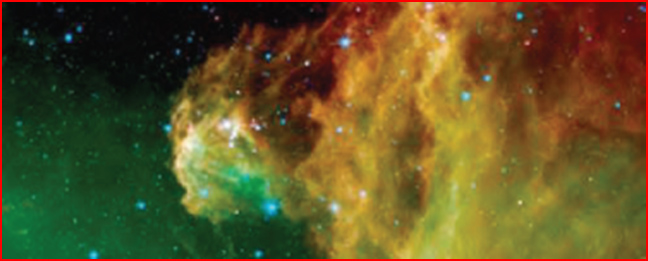
home •
about •
essential guide •
picture of the day •
thunderblogs •
news •
multimedia •
predictions •
products •
get involved •
contact
picture of the day archive subject index
False-color image of Barnard-30, an active "star-forming region" in Orion.
Credit: NASA/JPL-Caltech/D. Barrado y Navascués (LAEFF-INTA)
Nov 02, 2007
New Stars from Orion's Head
An energetic nebula in the constellation of Orion seems to be a stellar birthplace and nursery because of "collapsing gas clouds." But could electrical causes be producing the effects?
Look toward the East on any dark winter night and you'll see the constellation Orion, the Hunter. The stellar grouping includes two of the more unusual astronomical objects that have been identified: the red giant star Betelgeuse and the Orion Nebula.The Orion Nebula is faintly visible to the naked eye as the second star in Orion's sword. It looks somewhat fuzzy because it is not a star but a multi-light-year-wide cloud of interstellar dust and gas. The astrophysical community sees several formations within the nebular cloud to be star-forming regions because they have detected high frequency light from many active areas. Gamma rays, x-rays and high-frequency ultra-violet are being emitted by what have been termed "cosmic eggs" because they appear to be the glowing tips of condensed gas balls that have "ignited" in fusion reactions.
The image from the Spitzer Space Telescope is not from that familiar nebula, however. At the head of Orion, near the bright star Lambda Orionis, is another smaller cloud called Barnard-30, where scientists have discovered polycyclic aromatic hydrocarbons interspersed with the gas and dust.
When wood fires, stoves or other devices are not hot enough, some of the fuel is only partially burned, so its chemical properties are changed into a polymer without being completely carbonized. How the process works in space is not understood because no fire can burn there. The chemical compounds have been detected in Barnard-30 by their infrared signatures, however, along with water vapor and oxygen.
According to the standard model, new stars and hydrocarbons must be the result of a compression wave passing through the cloud. A supernova explosion "millions of years ago" in another part of the galaxy is what pushed the Barnard nebula (and other nebulae) into action, making stars and organic chemicals. At no time does electricity enter in to the discussion. "Hot gas" is used instead of the word "plasma". Researchers will occasionally admit that gas is plasma, but they mean "hot neutral gas" when they use the term. All analysis of the nebular clouds is based on kinetic models of gas behavior and not on the mathematics of electrified plasma.
An electric discharge in a plasma cloud creates a double layer, or sheath, along its axis. Positive charge builds up on one side and negative charge on the other. A strong electrical field exists between the sides and if enough current is applied the sheath will glow, but it is otherwise invisible.
Electric currents flow along the sheaths. In plasma, electric currents spiral into filaments, or double layer tubes. The filaments attract each other, but rather than merging they spiral around, gradually pinching down into arc mode discharges. Stars are born to such electrical parentage and not to the sterile hope of gravitational attraction.
The correct model for a nebula is a neon lamp that emits light only at the excitation frequency of that specific gas. Electricity passing through the tube causes the neon plasma to glow a pale yellow. Astronomers say a shock wave from a supernova is able to initiate many frequencies of light due to the heating of compressed gas. But, since more than 90% of the light from planetary nebulae is in the frequency range of ionized oxygen, then they should be thought of as oxygen discharge tubes and not as balls of gas.
Astronomers have infected physicists with the "hot gas" theory, causing a 50 year failed experiment with nuclear fusion. Squeezing hot gas into a volume small enough for fusion to take place has not worked and we predict that it will never work. The theory of star formation through fusion reactions is untenable so utilizing the theories of plasma behavior might be a more productive path.
By Stephen Smith
___________________________________________________________________________Please visit our Forum
The Electric Sky and The Electric Universe available now!

|
|

|
EXECUTIVE EDITORS:
David Talbott, Wallace Thornhill
MANAGING EDITORS:
Steve Smith, Mel Acheson
CONTRIBUTING EDITORS: Michael Armstrong, Dwardu Cardona,
Ev Cochrane,
C.J. Ransom, Don Scott, Rens van der Sluijs, Ian Tresman
WEBMASTER: Brian Talbott
Copyright 2007: thunderbolts.info
![]()
home •
thunderblogs •
forum •
picture of the day •
resources •
team •
updates •
contact us

